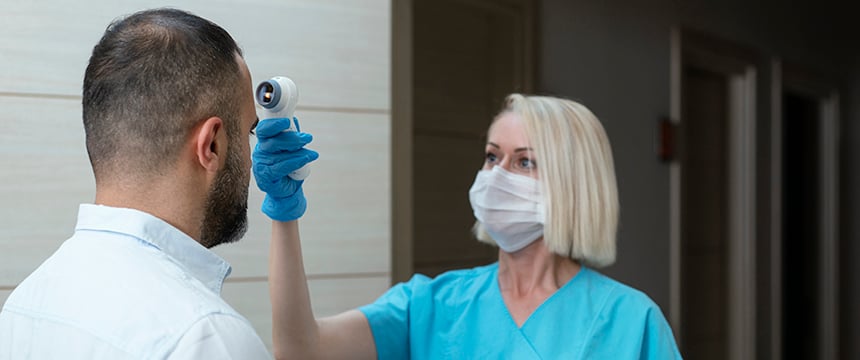Best Practices When Implementing a Program for Taking Employee Temperatures During the COVID-19 Pandemic

Businesses that remain operational during the COVID-19 pandemic are faced with the challenge of determining what they can do to minimize the risk of spreading the virus while still being able to provide critical products and services to our communities. Many of these essential employers have started screening employees’ temperatures in an effort to ensure that employees with symptoms of the illness do not infect their coworkers.
This article addresses some of the best practices that employers who elect to test employees’ temperatures can use to protect employees’ health and safety and to minimize their legal risks.
Background
In ordinary times, the Americans with Disabilities Act narrowly limits the circumstances under which employers can require medical examinations of employees – which includes temperature screening. Consistent with EEOC Guidance, employers could only take an employee’s temperature if doing so was “job-related and consistent with business necessity.”
But what constitutes business necessity is different during a pandemic. Not surprisingly, given the scope and severity of the COVID-19 pandemic, the Equal Employment Opportunity Commission – the agency tasked with enforcing the ADA – has stated that temperature checks during this time are valid and appropriate.
Nevertheless, for employers pursuing this practice, it is important they take steps to ensure that they are considering several different issues and complying with all applicable legal rules.
Who Should Take the Temperature?
Best Practice: For employers with a trained nurse or medical professional on-site, the trained personnel should be taking temperatures and/or training non-medical personnel to do so. In the event the nurse or medical professional is providing training to others, the training should be documented in writing.
For employers that do not have a trained nurse or medical professional on-site, the employer should designate one or more management-level personnel to conduct the testing. This individual should review the directions to use the thermometer or scanning equipment to ensure proper use. That individual should also be trained to follow up in the event of an error or a result that is inconsistent with common sense (i.e., a reading that is much too low or too high). The training process should be documented.
What Equipment Should We Use? What PPE Should the Temperature Taker Receive?
These questions are intertwined. Best Practice: is to use equipment that requires no direct contact between the temperature taker and the employees. Scanners that can measure temperature remotely are ideal. Forehead scanners also minimize the amount of contact. If you have issues sourcing these types of thermometers, oral or other types of thermometers are a reasonable substitute. In the latter case, make sure to clean the thermometers thoroughly between each employee, so as to not spread infection. Read and following the directions for cleaning that accompany the thermometer. If no directions are available, rinse the tip of the thermometer in cold water, clean it with alcohol or alcohol swabs, and then rinse it again before next use.
If you are using a temperature measurement that requires contact between the temperature taker and the employees, the taker should be equipped with adequate personal protective equipment to ensure safety for both parties. The taker should be provided with gloves, goggles, face masks, and gowns. If the taker is not using a “touchless” system, he or she should change gloves with each scan.
Waiting In Line and Taking Temperatures – Is this Time Compensable? What Are Some Best Practices for a Process that Respects Social Distancing?
The temperature taker is not the only one for whom best practices should be considered with a temperature-taking process; employers should be cognizant of the various states’ and municipalities’ social distancing requirements for the employees awaiting to have their temperatures checked as well.
Best Practices:
- Consider whether additional shifts can be established to reduce the number of employees in the worksite at one time
- Stagger shift start- and end-times greater than normal when possible (while still ensuring safe operations), to eliminate employees from congregating during the shift change-over, and from over-crowding at entrances and exits
- Create corridors (outside, but preferably covered) where employees can enter the facility through a temperature-checking line
- Have multiple such lines and entrances if possible to reduce crowding
- Consider placing markings (whether in tape or otherwise) on the ground in the corridor to demarcate six (6)-foot lengths to provide for greater social distancing by employees while in line
Whether employees must be compensated for time spent having their temperature taken (and waiting in line to do so) is likely to be a contested issue in the coming months. To the extent that any legal authority requires a temperature test before an employee is allowed to work, it is likely that time spent undertaking such a test will be compensable. However, even if such a test is not required, both good employee relations and state law requirements may counsel in favor of paying employees for this time.
Note also that the FLSA generally prohibits pausing compensable time once an employee’s work day starts (aside from an unpaid lunch period). Thus, if the employee’s compensable time begins with the temperature check (or waiting in line), all subsequent pre-shift activities will likely be compensable, as well. By implementing the Best Practices outlined above regarding staggered shifts, this should also reduce the amount of time spent by employees passing thru a temperature-checking process.
What Constitutes a Fever?
The CDC states that a fever for COVID-19 purposes is any temperature at 100.4 degrees Fahrenheit/38 degrees Celsius or higher. However, ensure that you also consult state and local guidelines regarding temperature levels. Certain state and local governments and agencies have set their own, more restrictive (and some less restrictive) thresholds for what constitutes a fever. Of course, such guidelines should dictate whether employers disqualify an employee from entering the work site.
An Employee Tested Positive. What Do We Do?
Discreetly notify the employee that he or she has a fever and do not allow him or her to enter the work environment. The employee should begin quarantine procedures, and should not return to work for 14 days, and only if by that point, the employee has been fever-free for three (3) days and is otherwise symptom-free as well.
Should I Keep a Record of the Temperature Checks?
While employers are permitted to take temperatures during this pandemic, if the temperature of employees are “recorded,” that information must be maintained confidentially under the ADA and only provided to those who should have knowledge of the information. Employers can also consider simply recording “no” (meaning the employee’s temperature is under the appropriate threshold) or “yes” (meaning the employee has a fever at 100.4 degrees or above) for each employee, instead of recording each individual employee’s specific temperature on any given work day. Regardless, the information that is recorded should be treated as a confidential medical document and not placed in any employee’s personnel file.
Final Word of Caution
Finally, note that taking employee temperatures and screening employees for fevers is not a silver bullet against the spread of COVID-19. There is still so much that the medical community does not know about COVID-19 and its spread. Current medical information suggests that individuals without any symptoms (i.e., asymptomatic) may nevertheless be infected with COVID-19 and still transmit the virus to others.
For this reason, taking temperatures does not eliminate the need to practice to maintain other steps to avoid the spread of the virus: maintaining social distancing best practices, including promoting remote work as much as possible; maintaining adequate distances between employees who are in the workplace; frequent hand washing and disinfecting; and, frequent cleaning and disinfecting of common areas and touch-points throughout the workplace.
Foley has created a multi-disciplinary and multi-jurisdictional team, which has prepared a wealth of topical client resources and is prepared to help our clients meet the legal and business challenges that the coronavirus outbreak is creating for stakeholders across a range of industries. Click here for Foley’s Coronavirus Resource Center to stay apprised of relevant developments, insights and resources to support your business during this challenging time. To receive this content directly in your inbox, click here and submit the form.

